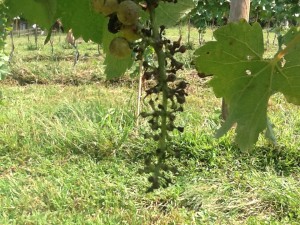Where Did the Grapes Go?
Five days ago, at the end of the holiday weekend, I was thrilled with the progress of our vines. We hadn’t allowed a lot of grapes to accumulate, given that the vines were only in their second year, but we had left a few clusters, and they looked beautiful. Moreover, they tasted amazingly sweet.
Alas, last weekend I had left my refractometer at the other house, and so I couldn’t measure the Brix, which would have told me how much sugar had accumulated in the grapes and therefore the potential alcohol. Not essential, given that we weren’t planning to make wine from this grapes, but it would have been nice to know. But I told myself, it’s Monday, I’ll be back on Friday, and I’ll be able to measure the Brix on Saturday morning. What could go wrong with that?
Well, of course, lots of things could go wrong. But what I wasn’t expecting when I returned this weekend was to find the grapes gone. Yes, gone. As in, missing. As in, virtually none of them left on the vine.
It turns out I was right about one thing. The grapes had ripened and accumulated a decent amount of sugar. Which meant that they were not only close to being ready for the crush, they had become attractive to lots of the critters that roam through the country near our vineyard. Birds, deer, badgers – who knows? Almost any animal cruising near our property could have decided to chow down on our grapes.
So, a few lessons.
First, we didn’t lose quite all the grapes. I had put bird netting up around some of the Cab Franc vines a few weeks before, and those grapes were largely intact. I measured the Brix and it came in at about 21.2 percent. Not bad. Not quite ready for the crush pad, but getting there. It’s been a horrible year with the rain and dark skies, but another week or two in the sun (assuming we get a week or two of sun) and they might have made pretty decent wine.
Second, among the grapes we didn’t lose were those in the “mother vineyard.” These are the Cab Franc vines we had planted in the first year before we even knew where the main vineyard would be located. We had purchased them for practice and never even really considered that we’d use them for wine. These, the critters left alone.
But why? Well, when I measured the Brix it was at about 16 percent. Not even remotely ripe enough for wine. So maybe these grapes were ignored because they weren’t sweet enough. Apparently the critters that hang around our property are pretty choosy in what they bite off.
That leaves open the question of why the Brix was so low in these vines. One possibility is that they were positioned at a point on our property that gets sun later in the morning, depriving them of an hour or so a day of potential ripening. Another is that they are a different clone from the rest of our Cab Franc. For these first, experimental vines, I had just wanted some stock to play with, and I wasn’t all that selective. There wasn’t much left to choose from at the time I ordered.
The clone we got is a UC Davis varietal. For the real vineyard, we were very selective. We picked a French ENTAV clone, specifically the ENTAV 214, which in the view of many is the best. Lucie Morton, the distinguished Virginia vineyard consultant, says that one reason Virginia wines, including Cab Franc, had come out so badly in the early years is that we were using bad clones. I believe she’s an advocate of the ENTAV 214, and who knows – maybe that made the difference. I may keep these UC Davis FPS (Foundation Plant Service) vines because they are pretty vigorous, but I think I’ll crush them separately from the rest of the vineyard.
In any event, when we arrived this weekend, the grapes had mysteriously vanished. A clue about what happened came Sunday morning while my wife, Chris – the Vineyard Goddess – was spraying the vines. She discovered a bird trapped in the netting, and naturally, she called me to deal with it.
OK, I sprung the little bird. But first, I gave it a stern talking to about the importance of respecting other people’s property. In particular, my property. I warned the little fellow that I wouldn’t be so nice next time, and told him to pass the word on to his friends.
I’m not sure he got all that, but I set him loose anyhow. He took off without a word of thanks.
I gotta say, this really is a tough business. You work so hard all season long to nurture the grapes along to the point that they’re ready to be made into wine, and then, at that very moment, all of nature descends upon the vineyard to feast on the fruit.
It’s enough to make you want to quit.
Well, my grandfather was a farmer in Iowa, and no matter how bad things got – and each year had its own set of challenges – he remained optimistic. He was always looking forward to the next spring planting and the next fall harvest (corn and wheat, not grapes).
I’m his grandson, and I inherited a bit of his spirit. And so I am sure, absolutely sure, that next year will be perfect. And I’m sure beyond any doubt that nature, from the weather to the critters, will cooperate and provide us a harvest of perfect grapes.
But just in case, I’m putting up more bird netting and reinforcing the deer fence. A weekend viticulturist can’t be too careful.
Category: All Posts, Viticulture



